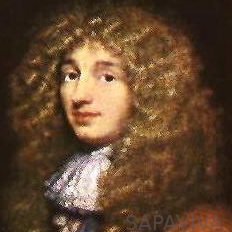(April 14, 1629 – July 8, 1695)
An outstanding 17th century researcher, Christiaan Huygens explored Mathematics, Physics, and Philosophy. He corresponded with Pierre de Fermat, Blaise Pascal, and René Descartes. He also exposed Gottfried Leibniz to advanced mathematics. After studying Galileo’s works, Huygens built the first pendulum clock. The accuracy of this invention ensured that it remained in vogue for almost three centuries. (From the 1650s until the 1930s when quartz took over, pendulum clocks were the most accurate man-made timepieces). He is as well credited with developing balance spring watch independently of Robert Hooke. Concerning Optics, Huygens presented his Wave Theory of Light to an erudite forum at the Paris Science Academy, who appreciated it. His lens-making skills enabled him to exchange ideas with Baruch Spinoza and Antonie van Leeuwenhoek. With the telescope he built, he was able to study Mars’ peripheries before focusing on Saturn, its rings and its largest moon: Titan. His math contributions extended to: Geometry, Algebra, Statistics, Logic, as well as to Applied Mathematics. These included research on the motions of objects, their impacts upon collisions, as well as on gravity. In the process, he became the first European known to have formulated math equation while expressing physics law. Although not an avid publisher of works, Huygens published the first Probability critique in Europe titled De Ratiociniis in Ludo Aleae (having learnt from preceding commentaries by Cardano, Fermat and Pascal). His other expositions pertained to Astronomy, Optics, and Mechanics. A variety of items (and concepts) are dedicated to his memory.
All rights reserved. © Valentine Oduenyi


I agree with the ratings. The criteria made them even more credible.
I appreciate your summaries. Christiaan Huygens is one of my favourites.
Thanks for the pendulum clock info.
Website is great, articles are excellent 😀 Good job.
Christiaan Huygens was truly great. Thanks for the post.
There is beauty in every page.
I will add you to my daily bloglist. You deserve it my friend 🙂
I would like to thank you for the efforts you’ve put in this site. Your creative writing skills inspired me to get my own website now.
I will surely be back again.
A very good info
Thanks
Really informative.
The more I read, the more I love this blog.
I adore all your posts.
Will you kindly drop me a mail?
Admiring the hard work you put into your blog and in depth information you offer.
Good vibes!
Thanks and cheers
Thanks for the great resources here.
Hello, hello, hello, I’m Natalie. I hope u are all enjoying this blog as much as i do.
Fantastic articles! Hardly anything else is required : D.
I call that his Age of Thiscovery.
I’ve been exploring a little bit. While in Yahoo I stumbled upon this site. Awesome.
It was a new dawn for him.
Good conclusion
I have always liked your posts.
Broadcast it louder !
A new addition to my feed / reader.
I once again find myself spending way to much time here. But so what, it’s worth it!
yes, more like it.
His genius sprocket <<>> Learn from Pascal, teach to Leibniz.
Huygens was very capable and versatile.
G-E-N-I-U-S